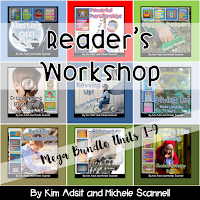- They develop language and listening skills.
- They develop communication skills by learning new vocabulary and numeracy.
- They enhance physical development when actions are incorporated.
- They develop cognitive skills such as memory, concentration and spatial relationships.
- They enhance individual development of social skills, better self control, and higher confidence and self esteem.
- They enhance brain development through music and movement.
- They develop the part of the brain that controls motor development and planning.
Here are a few ways we are using nursery rhymes in our classrooms:
As we learn a new nursery rhyme, we reproduce a copy of the rhyme and add it to our poetry notebook. This is a good way for kids to develop fluency...or more specifically prosody. As the children read the rhythmic rhyme they become better readers! It's also a great way to practice one of the ways we teach our kids to read with partners...read together.Another thing our kids enjoy is to use the nursery rhyme wheels.
To make the wheels, invite the children to color and cut out the two circles.
Stack the wheels on top of each other. Add a brad into the center (black dot). As the kids turn the wheel, the pictures for retelling appear in the "window."
Another idea is to make crafts that will help the kids in retelling the rhymes.
To make this fun Humpty Dumpty craft, invite the children to cut and sequence the pictures on the strip. Add the chimney to the top. Attach Humpty Dumpty with a brad. As the kids say the rhyme, they can rotate Humpty Dumpty when he falls down.
Don't be so quick to send these activities home. We added them to our bag of books. They are great for reading with friends during our partner reading time.
Another fun rhyme is Baa, Baa Black Sheep. To remember this rhyme, we invited our kids to make this fun cut, stack, staple and read book.
The kids wrote the color words on each of the sheep. Then, they stack the sheep in a pile. Finally, staple the sheep to the Baa, Baa Black Sheep strip.
Now, enjoy reading your book with your partner!
To introduce each rhyme, we made the words to sequence each of the sentences. I grouped the words needed for each sentence and placed them in the pocket chart. I placed the pictures at the bottom and invited to kids to help me sequence the pictures to tell the rhyme.
Then, we took the words to match the pictures and sequenced them to make the sentences.
All of these activities are from the nursery rhyme unit that I wrote with my good friend Kim Jordano, kinderbykim.
The unit contains the poetry page for 6 popular nursery rhymes.
It also includes the retelling wheels for each of the 6 nursery rhymes.
For each of the rhymes, all of the pieces to make a craft are also included. It also includes a color photo for reference and a page with step by step directions.
And finally, for each rhyme, the sequence pictures and the word cards for each rhyme are included.





















































